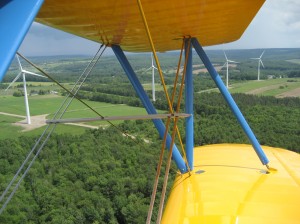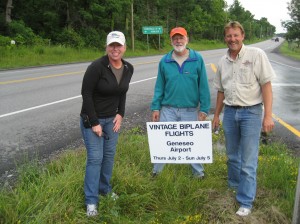I took off my watch when I left Florida in June, I knew I wouldn’t need it that summer. My days would be measured in hours of daylight, gallons of fuel remaining, and the number of thirty minute flights I could do before the light or the gas ran out. Time is redefined when Barnstorming. Late for work just means your loader has to juggle the schedule or placate the passenger until you get back on track. Early for work means you get to finish your second cup of coffee before your first flight arrives; characteristically early as enthusiastic passengers always do. Weekends become workdays, Mondays become weekends, and even those days are filled with some kind of work. Oil changes, maintenance, cleaning, ferrying to the next stop. Yet none of it feel like work, its just what you do. I am proud of what I do.
We set off to New York from Miller Field in eastern Indiana, the big green New Standard and the Stearman. Both biplanes and the pilots loaded up with fuel for the long trip ahead. The New Standard carries two pilots but you can only see one this morning because the front cockpit is piled high with tents, banners, bins, and all the stuff necessary for us to hop rides. Scooter, the owner, knows he flies the “family station wagon” and is willing to be permanently stuck carrying everyones extra baggage. Somewhere in the forward cockpit another pilot, Pops, is wedged in between all our must have’s, should have’s, and just in case things. You can barely see his head over the left side of the cowling. We fly low above the open fields of Indiana into western Ohio and I watch the New Standard sashaying left and right behind my wing. Dropping down to look at a house or landmark, then popping back up near me. I keep checking over my shoulder to see if they are in trail. Scooter doesn’t have a radio, its against his “barnstormers creed” to put one in, so I cant talk to him. I don’t mind checking on him, I actually like looking at the New Standard. Other biplanes are prettier or more sleek, but the New Standard was built for a single purpose – to give rides, and because of that it is particularly beautiful to me. It’s doing what it was built to do, work, just like my Stearman. I like planes that have a job. So the six of us, four pilots and two planes went off to work like an arial carney caravan across the fields to Geneseo, NY.
 As we pass south of Cleveland the sky gets lower and the morning’s warmth disappears with the sunlight. Even-though we are all bundled in leather jackets and gloves everyone is cold. The playing and swaying between the two planes stops and goal becomes getting there as quickly as possible. Short fuel stops, coffee and cookies, no lunch, 3 hours spent skirting rain and rising terrain. We break out of the low overcast and drizzle just west of the Geneseo Valley into rolling green hills sprouting giant white stalks of windmills. The smells of wet grass and hay rise with the sunlight as thick, humid air floods into to my cockpit and I smile as I signal to the New Standard I am going lower. I love windmill farms. I consider them my personal playmates and always greet them the same way by dropping down to their level to meet them. I weave my way through forty or so white whirling blades, picking just the right solum course to let me stay near them as long as possible before I have to head back. Scooter drops down after I clear their trunks and joins up on my wing for a slow parade up Silver Lake announcing the barnstormers are in town. Its hard to imagine the anticipation you feel upon arriving at each new town. Will they come out to fly? Will it rain all weekend? Will people pay for rides this summer when the economy is so bad?
As we pass south of Cleveland the sky gets lower and the morning’s warmth disappears with the sunlight. Even-though we are all bundled in leather jackets and gloves everyone is cold. The playing and swaying between the two planes stops and goal becomes getting there as quickly as possible. Short fuel stops, coffee and cookies, no lunch, 3 hours spent skirting rain and rising terrain. We break out of the low overcast and drizzle just west of the Geneseo Valley into rolling green hills sprouting giant white stalks of windmills. The smells of wet grass and hay rise with the sunlight as thick, humid air floods into to my cockpit and I smile as I signal to the New Standard I am going lower. I love windmill farms. I consider them my personal playmates and always greet them the same way by dropping down to their level to meet them. I weave my way through forty or so white whirling blades, picking just the right solum course to let me stay near them as long as possible before I have to head back. Scooter drops down after I clear their trunks and joins up on my wing for a slow parade up Silver Lake announcing the barnstormers are in town. Its hard to imagine the anticipation you feel upon arriving at each new town. Will they come out to fly? Will it rain all weekend? Will people pay for rides this summer when the economy is so bad?
We land on the thick grass runway and taxi through a path in the hayfields to the museum. The first priority is always the planes. Where will they be safe tonight? Once we verify there is hangar space, we turn our attention to other business; getting passengers. Banners go up on roadside fence posts and signs are staked in the ground at each intersection announcing “Biplane Flights at the Airport”. Before dusk we hop back in the planes to circle the town and lake to complete our advertising campaign. Tomorrow I need the first ride to pay for the hotel, second ride will buy me a tank of fuel, third ride meals and drinks, forth ride I start making money. The challenge of coaxing the lookers and drawing fliers to your plane is addicting, and each airport holds unlimited potential. Now we will wait and see what the morning brings.
Rain. Thick and steady bands all morning, so Chuck and I sit, and we clean. Around 11 am cars start arriving down the long gravel road from the highway. Pick-ups and older american models packed with family members start to trickle in, in the rain. Curious, they pull up next to the hangar and roll down their window, just enough to not get wet and ask, “Are there biplane rides today?” “Sure if you don’t mind waiting with us here in the hanger until we get a break in the rain,” I reply. Everyone chooses to wait, so in between showers and Stearman flights we entertain them by telling the history of the biplanes and barnstorming stories; loading them in and out of the cockpits for photos. It works and by the end of the day I have six flights, all cash. Friday’s slow for the Stearman and I start to worry that these folks might not have the money to afford the “expensive” flight. After all $200.00 dollars for a 30 minute ‘hands-on’ flight is a great deal, especially this year. Saturday the sun shines brighter and both planes start to get busy. Sunday, really busy, and I only leave the cockpit to fuel and run to the bathroom. The rhythm of the job begins. Greet, load, fly, land, unload, photo, hand-shake, sign logbook, repeat. The two biplanes and four crew work in perfect sync and economy of movement. Take-off with a tailwind from the edge of the hayfield, land into the wind by the windsock to make the taxiway turn off. No waste of energy or time. Sunscreen and engine oil burn my eyes and my left hand is covered with the names of the days passengers, as it is impossible to remember them all. Around 7 p.m. the people stop coming and we sit alone in the field to tally up the weekends receipts, both planes and pilots tired and happy for the good work, and for a job worth doing.
 The same scenario repeated itself again and again that summer, barnstorming in small towns like Freeport, Wausau, and DeKalb. Each airport held unlimited potential and also the fear that no one would have the money to fly in a year being dubbed ‘The Second Depression.’ But you see they did come out to fly. At each town farmers, factory workers, and families arrived with cash in bank envelopes, happy to spend it all just to fly a biplane. None of them looked affluent, but they never complained that today’s flight might mean a sacrifice for them later that month. They wanted the thrill of attempting something new, and to perhaps be a little bit daring in a time when everyone was telling them to be conservative. Most of the Stearman fliers weren’t pilots, but they had always wondered what it would feel like to be one. What I offered them was of great value; a chance to trade places with whom they wished they could be, to actually become it. A perfect escape, suspending them above their world for a brief time, where the only things they could think about were the smell of the wind, the rumble of the engine, and the joy they felt when seeing their town from the air in an open-cockpit biplane.
The same scenario repeated itself again and again that summer, barnstorming in small towns like Freeport, Wausau, and DeKalb. Each airport held unlimited potential and also the fear that no one would have the money to fly in a year being dubbed ‘The Second Depression.’ But you see they did come out to fly. At each town farmers, factory workers, and families arrived with cash in bank envelopes, happy to spend it all just to fly a biplane. None of them looked affluent, but they never complained that today’s flight might mean a sacrifice for them later that month. They wanted the thrill of attempting something new, and to perhaps be a little bit daring in a time when everyone was telling them to be conservative. Most of the Stearman fliers weren’t pilots, but they had always wondered what it would feel like to be one. What I offered them was of great value; a chance to trade places with whom they wished they could be, to actually become it. A perfect escape, suspending them above their world for a brief time, where the only things they could think about were the smell of the wind, the rumble of the engine, and the joy they felt when seeing their town from the air in an open-cockpit biplane.
